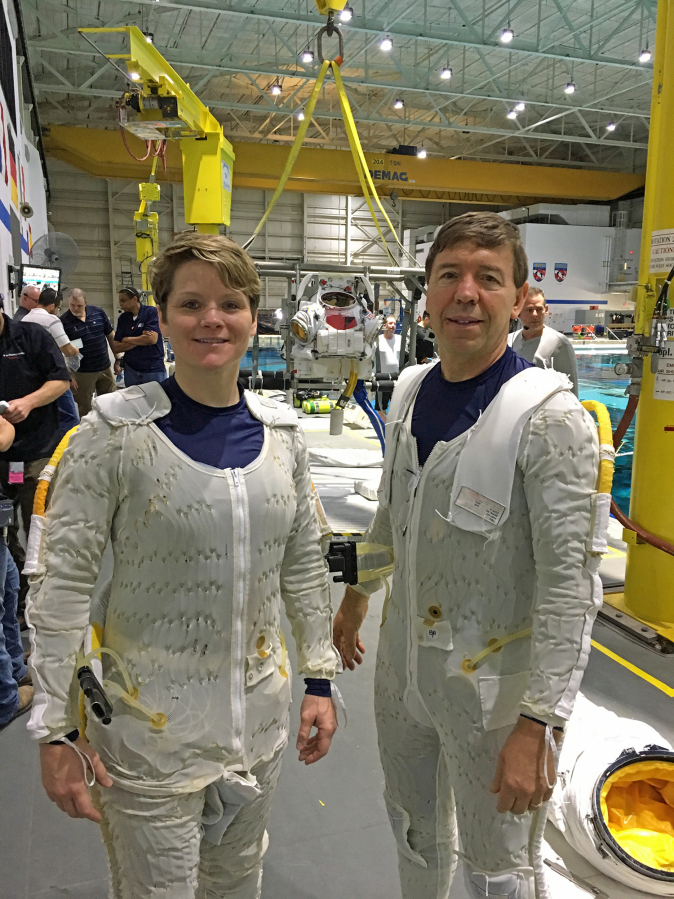You’re gazing continuously at one object, yet the view never gets old.
That’s one reason why Mike Barratt is hoping to return to space. He wants to see Earth from one of the best vantage points a person could have.
“It’s the thing everybody wants to go back and repeat: looking out the window at our home planet. You never get tired of it,” said Barratt, who was aboard the International Space Station in 2009 and 2011.
“I was able to do two spacewalks and would love to do more spacewalks,” he said. “That’s probably the holy grail.”
The Camas native now is a deputy chief in NASA’s Astronaut Office, but he’s still an active astronaut.
Man in Space
• Expedition 19/20, March 26 to Oct. 11, 2009: Mike Barratt launched as flight engineer on Russia’s Soyuz TMA 14. Barratt performed two spacewalks during 199 days in space.
• STS-133, Feb. 24 to March 9, 2011: Barratt served as mission specialist on STS-133, the 39th and final mission for space shuttle Discovery. He served as lead for rendezvous and station robotics during the 13-day flight.
“They’re still keeping me current, and I’m flight eligible. I’m hoping to fly one more time,” said Barratt, who has spent 212 days in space.
At 58, Barratt is not out of the picture.
“Once you’re in, age isn’t what it used to be. We fly people into their early 60s, as long as they’re healthy and fit, and still flight eligible.”
Flight eligible means regular training sessions flying T-38 jets, remaining fluent in Russian and staying current on space station operations.
It also means spacewalk practice, which astronauts can do without leaving Houston. They train underwater, in the Johnson Space Center’s neutral buoyancy lab.
Barratt went through a training session a few weeks ago with fellow astronaut Anne McClain. Their session was designed to help astronauts on the space station prepare for an actual spacewalk — “Working out the kinks for the crew,” the 1977 Camas High grad said.
While it was a run-through, “It was about six hours of very intensive physical activity.”
Barratt’s last taste of actual weightlessness came during a 13-day space station stint that ended on March 9, 2011. That also was the final flight for space shuttle Discovery, as NASA phased out its shuttle fleet.
Not a bureaucrat
In January 2012, Barratt was tapped for research management.
“I worked with international partners, trying to synchronize NASA’s research portfolio with Russia and with the European Space Agency. I was overseas a lot, and at enterprises at four different NASA centers. I was not bred to be a research bureaucrat. I worked hard to find a successor,” Barratt said in a phone interview while back in the Northwest for a talk at the Museum of Flight in Seattle.
Now he’s part of the program to develop the new vehicle that will carry astronauts to the space station, focusing on health issues.
“Space medicine is the reason I came to NASA,” said Barratt, who is a physician and flight surgeon.
The roster of players in the launch game has expanded recently. NASA has contracted with Boeing and SpaceX in what’s called the commercial crew transport program.
The next destination hasn’t been determined, but a presidential signing two months ago was a good start.
“What President Trump signed was the NASA Authorization Act of 2017, which we are happy about for many reasons,” Barratt said. “We haven’t had a true authorization act for seven years; these are usually annual but have been circumvented in past years by omnibus spending bills. We were nearly fully funded, which is very good for a federal agency these days.
“And important to my community, this includes language on long-term surveillance for spaceflight-related astronaut health issues.”
That measure (To Research, Evaluate, Assess, and Treat Astronauts) is known as the TREAT Act.
We can’t really understand the complete effects of spaceflight on humans without looking long-term for effects of radiation, vision changes and loss of bone mass, Barratt said.
News coverage of that authorization act noted that sending humans to Mars by the 2030s remains NASA’s long-term goal. Meanwhile, there are closer targets, such as the asteroids and a return to the moon — which is still mankind’s most distant perch for looking back at Earth.
Higher ambitions
“Gosh,” Barratt said. The moon-mission astronauts “are in their 80s and 90s, and we haven’t left low-Earth orbit” since Apollo 17 in 1972.
“That’s just unbelievable to a lot of us. We’re way overdue to explore beyond low-Earth orbit,” Barratt said. It’s a goal that is “bipartisan in Congress and shared among all our international partners.”
Even if Barratt doesn’t make the trip, he figures to be part of the team.
“Even when I’m done with my space-flight career, I plan to stick around. As long as I can contribute: It could be another five or 10 or 20 years,” Barratt said. “I’m still having a lot of fun.
“There is so much to be discovered. Astronauts probably are happiest when learning new things. There still are a lot of new things to learn.”




